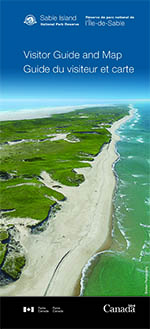Sable Island Visitor Guide and Map
Sable Island National Park Reserve
Plan your trip to Sable Island National Park Reserve with the Visitor Guide and Map.

Sable Island Visitor Guide and Map
Download (PDF, 14 MB)
A fascinating island
Sable Island National Park Reserve is a wild and windswept crescent shaped island of sand, seemingly emerging out of nowhere amidst the great expanse of the North Atlantic. The forces of nature dominate all life here, past and present. Located 160 km from its closest landfall in mainland Nova Scotia, this isolated and remote island is teeming with life, a testament to the power of nature and survival.
The Mi'kma'ki Sable Island Pledge
Make a pledge for your visit to the protected Mi’kmaw land we call Sable Island.
Guidelines
To ensure a safe and enjoyable trip, and to help protect Sable Island National Park Reserve, please follow the guidelines below.
Taking care of yourself and taking care of the island
Maps
Maps of Sable Island, Main Station, and Bald Dune
Culture and history
L'nu'k presence at Sable Island
Sable Island was larger and closer to the mainland during the Paleo-Indian period, a time where we have archaeological evidence of L'nu'k in Mi'kma'ki. Bridges made from glacial ice sheets would have allowed L'nu'k to walk to a land mass close to Sable Island, making a visit to the island a short sail less than 10 km away. An archaeological survey of the modern island may turn up tangible, archaeological evidence. However, due to the shifting sands, it would be like finding a proverbial needle in the haystack.
Recent History
For over four centuries, explorers, hunters, fishermen, entrepreneurs, and scavengers have been attracted to Sable Island. More than 350 vessels have been wrecked due to rough seas, fog, and sandbars, earning it the title “Graveyard of the Atlantic”. As a result, the Government of Nova Scotia established a life-saving station here in 1801 in an effort to reduce the suffering and loss of life and cargo resulting from frequent shipwrecks. A weather observation station was in operation for 75 years prior to the island’s designation as a National Park Reserve in 2013.
Nature
Wild horses
The Sable Island horses roam freely throughout the island feeding primarily on the abundant marram grass. Brought here by people in the 1700s, and believed to be mainly of Acadian stock, they have developed through time into a distinct breed. Protected since 1961, the roughly five hundred horses that call Sable Island home are an extraordinary representation of a wild and free horse population.
Seal's haven
The island is home to the world’s largest breeding colony of grey seals. Hundreds of thousands descend on the island in winter to pup and breed. In summer, tens of thousands use the beaches to rest from predators, creating a wildlife experience like no other. Harbour seals add to the excitement in the spring when they too come to the island to pup.
More than just sand
The sandy dunes of Sable Island are dominated by fields of marram grass covering one third of the entire island. Their long roots stabilize the dunes creating an environment for other plants to flourish. Surprisingly, delicate orchids and cranberries thrive in the wetter areas, and heath plants form thick blankets throughout the island. Some of the freshwater ponds burst with colour from beautiful irises and waterlilies.
Essential freshwater
Life cannot exist without freshwater and Sable Island is no exception. Underneath the sand lies a freshwater bubble or “lens” that sits on a much denser saltwater layer. This unlikely source of freshwater supports all life on Sable Island. Several permanent ponds teeming with a variety of life such as aquatic plants, insects and fish contributing to what what makes this a remarkable island in the sea.
Species at Risk
Sable Island is home to many species that are at risk of disappearing from the world. The rare Roseate Terns nest in small numbers in Common Tern colonies. The Ipswich Sparrow, a subspecies of the Savannah Sparrow, nest nowhere else on the planet. Rarer still is the Sable Island Sweat Bee that exists only on Sable Island.
- Date modified :